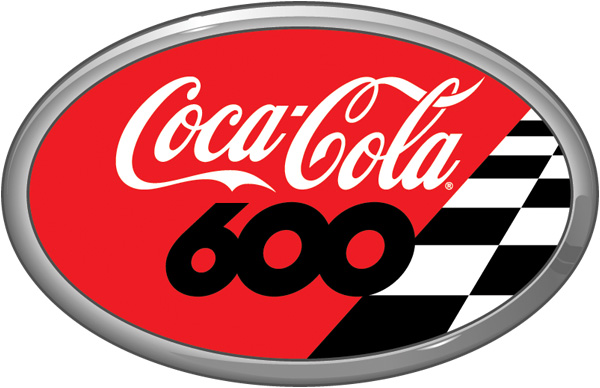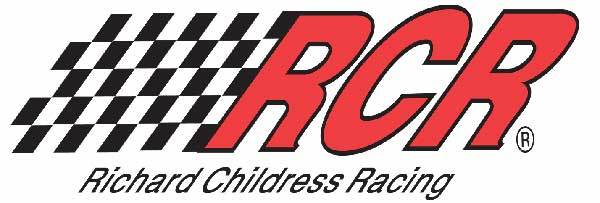We are closing in fast on a very prominent day in the motorsports world. The Monaco Grand Prix will be held on Sunday, followed by the 97th edition of the Indianapolis 500, and the day will conclude with the longest race in NASCAR, the Coke 600. Whoever wins these races will forever solidify their position in racing lore as others aspire to replicate previous triumphs. The talk in the racing community includes picking favorites for the races, discussing qualifying results or recalling memories from past events, but I want to look at something a little bit different than all that. On this weekend of legendary races, I want to remember some legendary racers who lost their lives in pursuit of racing immortality, and their untimely death only helped to further solidify their position in time.
We all know the names Gurney, Petty, Andretti, Schumacher, and Foyt. All are obvious legends but that’s not who I will be focusing on here. We are blessed that these brave men are still with us today and are capable of telling their astonishing tales from when they strapped into race cars wearing blue jeans and blasted to speeds nearing 200mph with no fear, only desire. Instead, I am going to talk about the legends who can no longer tell their harrowing stories. I want to remember the ones that strapped into their cars with no fear of death but unlike the men mentioned above, never came back. I mean the men that paid the ultimate price and whose stories live on only in the voices of those who are willing to tell them. Today, I want to be that voice as I take some time to remember some of racing’s fallen heroes. These are all names every race fan should know, although some unfortunately do not. I can assure you that by the time you finish reading, you will surely know every single one of these remarkable men.
Jim Clark
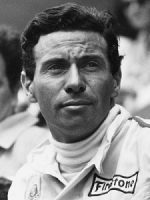
1936-1968
Jim was a Scottish born racer and was one of the more versatile drivers of his time. He won in sports cars, open wheel, touring cars and even tried his hand at NASCAR. In 1965, he succeeded in winning the Indianapolis 500 with help from the famous Wood Brothers pit crew. He thought he had it won again in 1966 before a scoring debacle that officially placed him 2nd to Graham Hill. Jim had a lot of Formula 1 success, winning 25 races and 33 poles in just 72 starts. He was also crowned champion in both 1963 and 1965. Clark won titles in British Touring Cars as well as in the old Tasman Series. Nothing could shake this man and he could not be forced into a mistake. Jean-Pierre Beltoise insisted on calling him a “demi-god” when asked about Jim’s superb driving ability. His fellow competitors recognized his extraordinary talent and respected him for it while the humble Clark rarely cared to discuss how good he really was, although he knew.
In 1968, Clark was riding a high after concluding the 1967 season with back-to-back victories. He continued the streak by winning the opening round of the season in South Africa. Little did he know that he would never get the chance to make it four in succession. In April of that year, he competed in a F2 race at the notorious Hockenheimring in Germany. During the event, he crashed into a group of trees due to what was thought to be a flat tire but that was never officially confirmed. No matter what caused him to wreck, all that was certain was that we had lost Jim Clark at the age of 32. Jimmy Clark is remembered for his uncanny ability to adapt to any kind of car and excel in it. He was a man of impeccable character who never showed fear. Jackie Stewart said following Clark’s death, “He was so smooth, he was so clean, he drove with such finesse. He never bullied a racing car, he sort of caressed it into doing the things he wanted it to do”
Richie Evans
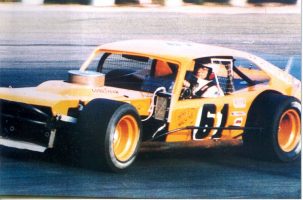
1941-1985
Evans grew up in Rome, New York. At the age of 16, he left the family farm to pursue a career driving race cars. The “Rapid Roman,” as many insisted on calling him, was the King of the Modifieds. He amassed nine titles in the series, including a record eight in-a-row, which the International Motorsports Hall of Fame calls “one of the supreme accomplishments in motorsports.” Along with nine championships in just 13 years, he also collected over 400 feature wins. His orange No.61 is just about as iconic in NASCAR as Dale Earnhardt’s black No.3 or the “Petty blue” No.43. If he wanted to, he could have gone and raced in NASCAR’s premier series but he was perfectly content doing what he loved and that was racing modifieds at local short tracks. He was certainly a character who loved to have fun but when he was on the track, Evans turned into a ruthless opponent that was near-infalliable. Everybody knew he was one of the greatest, he knew he was one of the greatest, but he never bragged on himself and frankly, he didn’t need to.
It was practically impossible to beat this man; he even won a race sliding on his side across the line after he and Geoff Bodine collided as they roared towards the checkered flag. His car owner said once that Richie didn’t know the words “it can’t be done.” He worked on his own cars from dusk till dawn and was a true grassroots racer. He would even help fellow competitors out with setups knowing that no matter how fast they made their cars, he’d still triumph over them in the end. In 1985, Evans clinched his 9th title with a few races remaining and was just out there to add some more trophies to his vast collection. During practice at Martinsville though, tragedy struck when the 44 year old Evans crashed heavily into the wall, perishing in the accident. His friends, family and fans were left in utter shock. After all these years, all these races, he dies in an accident during practice. Who knows how many more races and championships he would have accumulated but one thing’s for certain, what he had already accomplished was more than enough to secure him a spot in racing history. In 2011, he became the first regional racer of NASCAR to be inducted into the NASCAR Hall of Fame, beating legends such as Rusty Wallace, Bill Elliott and Tim Flock. He may be gone but because of the people that devoted their lives to keeping his memory alive, no one has forgotten about this true legend of NASCAR.
Fireball Roberts
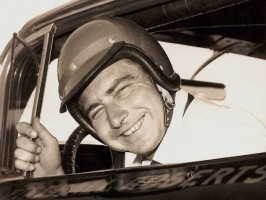
Commonly referred to as NASCAR’s first superstar, Edward Glenn “Fireball” Roberts was one of the few men in the 1950’s and 60’s that could go wheel-to-wheel with the likes of Richard and Lee Petty and defeat them. Fireball was not only a talented racer, but also a pretty good baseball player. In fact, his fast ball is what earned him the nickname, “Fireball” Roberts. He never won a NASCAR championship but that is simply because he never felt like trying to. Only twice in his fifteen year career did he even run more than half the races on the schedule. In 1950, he just about won the title despite failing to start 10 of the 19 races that season. That’s how good this guy was. His 33 wins and 32 poles surpass the numbers of many NASCAR champions today including Matt Kenseth, Terry Labonte and Dale Jarrett. When the helmet was off, he was a fun-loving guy who liked to joke around but when he got into that car, he morphed into a very different man. Fireball’s highly aggressive, balls to the wall style of driving, struck fear into the minds of his adversaries and captured the hearts of thousands of fans.
Fireball was a very unique driver for his time in the fact that he was a college graduate and very articulate when he spoke. In 1962, he won the Daytona 500 in dominating fashion over Richard Petty. Fireball started the 1964 World 600 (now known as Coke 600) from the 11th position but only completed seven laps before he was involved in a vicious crash that also took out superstars Junior Johnson and Ned Jarrett. Roberts’ car flipped over and erupted into a fiery inferno. Ned was able to pull him from the wreckage and it seemed like he would miraculously pull through, despite his horrendous injuries, until he contracted phenomena. At 7:13am in room 3305 at Charlotte Memorial Hospital on Thursday, July 2, 1964, Fireball Roberts’ six week struggle for survival came to a tragic and unfortunate end, succumbing to blood poisoning and an incredibly high fever. Due to his death, NASCAR mandated that all drivers must wear flame retardant coveralls at all times and steel fuel tanks were replaced by rubber fuel cells.
Mark Donohue
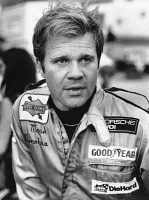
The New Jersey native won the 1961 SCCA national championship, but his racing career really kicked into high gear when he met a man by the name of Walt Hansgen. He recognized the natural talent Donohue possessed and took it upon himself to give him a shot as his teammate in 1965. He edged closer and closer to a major breakthrough after finishing on the podium in both the 12 Hours of Sebring and 24 Hours of Daytona in 1966. Sadly, Walt was killed that same year while testing a GT40 in preparation for Le Mans.
The following year, Donohue and another racing genius (Bruce McLaren) were paired up for Le Mans and the two clashed over setups on more than one occasion. Mark Donohue is responsible for putting car owner Roger Penske on the map and it all started when he won the 1967 United States Road Racing Championship with Penske (Evolved into what is now the Rolex Sports Car Series),and they would hold that title for two consecutive years. The pair decided to take on Trans-Am where they also dominated, winning three titles in a period of four years. Along with multiple class wins at Sebring, Donohue claimed the overall victory in the 1969 24 Hours of Daytona. Penske and Donohue decided to tackle Indianapolis where they would finish 7th in their first attempt. Three years later, they found themselves in victory lane after winning this highly prestigious race by a hefty margin over Al Unser. It was the first of what would be many Indy 500 victories for “The Captain,” Roger Penske. Mark also tried his hand at NASCAR with backing from Penske and in just his 5th start, he took the checkered flag at Riverside over NASCAR HOF’er Bobby Allison. It was the first win in NASCAR for the now championship winning car owner, Roger Penske.
Donohue was asked by Porsche to test their new 917/10 in the early 70’s (aka the “Can-Am Killer”) and he was more than willing to help them try to suppress the stranglehold McLaren had on Can-Am at the time. They were successful but there were certainly some bumps in the road along the way, including Mark’s violent wreck during a test at Road Atlanta. Donohue recommended larger brake ducts in order to provide more efficient cooling, which would consequently, cause less degradation as a race wears on. They obliged him but the new brake ducts interfered with the bodywork closure pins which hold the bodywork on the car. The bodywork flew off at full speed, resulting in a terrifying airborne accident that left Donohue with a broken leg, but he was lucky to escape with his life. George Follmer was his replacement while he recovered and drove the car to the 1972 Can-Am championship before Mark returned to repeat Follmer’s performance in ’73.
The pressures of racing and the death of his friend Swede Savage in the Indy 500 pushed Donohue to retire, but he didn’t stay away long. When racing is in your blood like that, it’s nearly impossible to walk away from it. It’s a hunger that you must suffice. The desire to win supersedes the fear of what could go wrong. In 1974, Donohue dominated the inaugural season of IROC, taking the championship after winning three out of four races on the schedule. Roger coaxed him into competing full-time in the 1975 Formula 1 season but the unthinkable happened towards the end of the year. He crashed violently during practice for the Grand Prix of Austria which resulted in the death of a track marshal due to flying debris. Mark seemed fine at first, only complaining about a headache. It worsened though and he was taken to a hospital the next day where he lapsed into a coma from a cerebral hemorrhage and died. Mark Donohue is remembered as one of the most versatile drivers that ever lived and a true engineering genius who helped build Penske Racing into the powerhouse it is today.
Joe Weatherly
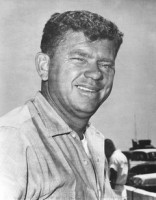
1922-1964
This NASCAR pioneer lived a life style that isn’t one for the faint of heart. He loved to behave outrageously and do some pretty crazy things with best friend and fellow NASCAR legend, Curtis Turner. His antics earned him the nickname “The Clown Prince of Racing,” which he lived up to on more than one occasion. One of his favorite jokes was throwing a rubber snake at people who were of course, terrified of them. When he wasn’t busy pulling pranks on fellow drivers, he was kicking their butt’s on the racetrack. The 1953 NASCAR Modified champion won his first race at the Cup level in 1958 at Nashville Speedway.
In 1961, he teamed up with World War II veteran and NASCAR HOF’er Bud Moore and together, they won nine races, en route to a respectable 4th place result in the championship standings. He won the 1961 American Challenge Cup at Daytona International Speedway, which some people consider to be NASCAR’s unofficial first All-Star Race. 1962 was his year. After emerging victorious nine times during the year, he won the title by a massive margin over Richard Petty. Joe did something in 1963 that had never been done before or since; he won his second championship while driving for NINE different race teams! That’s a spectacular feat for any driver from any era and in any discipline. Weatherly was a stock car driver and he could care less about sports cars or open wheel. In fact, he described the American open wheel cars of the time as “cucumbers with hayraker wheels.” Between Cup, Modifieds and the NASCAR Convertible series, “Little Joe” had amassed well over 100 race wins in his career along with three championships.
One of the many wild stories involving pugnacious Joe Weatherly was when he and Curtis Turner decided to race their rental cars back to the motel and the prize for being the first one there; well it was a bottle of Canadian Club Whiskey. The two slammed fenders as they raced down the road and this should sound oddly familiar to anyone who has seen the movie “Days of Thunder” and it should…where do you think they got the idea from? As the two neared the motel, Weatherly was hell bent on winning and applied the brakes too late, ending up in a swimming pool. Soaking wet and grinning from ear-to-ear, he stood triumphant as he gulped down that coveted bottle of Canadian Club. That’s Joe Weatherly for you.
In 1964, it looked like he would win his 3rd straight championship but all that changed when NASCAR visited Riverside. Early in the race, he crashed his Mercury and hit his head on the guardrail, killed him instantly. He never got a shot at winning three in-a-row and who knows if he could have won a 4th or maybe even a 5th championship, had he survived. He was the first death of many in 1964 which is considered one of the darkest years in NASCAR history. His death prompted NASCAR to institute better roll cages to keep drivers hands and head inside the car during wrecks. He was lost well before his time and I truly believe he would have put up numbers rivaling stock car racing’s best. 50 years later, he is remembered for being a wild, on the edge character that loved to take risks, could wheel a race car better than most and most important of all, he always lived life to the fullest.
Bruce McLaren

I’m sure you all know of that last name even if you don’t know the face behind it. Bruce McLaren is the founder of the famous McLaren Formula 1 team and European manufacturer of high performance vehicles. In 1959, he won the United States Grand Prix at Sebring, after a riveting last lap where he made a risky pass for the lead. In 1962, Bruce emerged triumphant in the Monaco Grand Prix; arguably Formula 1’s most important race. Bruce was the inaugural Tasman champion, a 2x Can-Am titlist as a driver and the winner of the 1966 24 Hours of Le Mans. Although he had a very impressive career as a driver, it’s what he put on the track that he’s best known for. His car designs won five straight Can-Am championships and even won every race on the schedule in 1969. During a test once, he noticed that the fuel filler access door was flapping up and down and common knowledge at the time said that it should be pressed more firmly in place. Well, he immediately pulled into the pits, ran to the tool box, grabbed some shears and started cutting the bodywork away from behind the radiator. When he went back out, he was turning much faster lap times and just like that, the “nostrils” were born; a key feature utilized by McLaren to this day.
On June 2nd, 1970, Bruce crashed during a Can-Am race when the rear bodywork came adrift, destabilizing the car. The 32 year old was killed instantly.He wrote this very eerie paragraph six years before his own demise when referring to the death of Timmy Mayer in his book, From the Cockpit. “The news that he had died instantly was a terrible shock to all of us, but who is to say that he had not seen more, done more and learned more in his few years than many people do in a lifetime? To do something well is so worthwhile that to die trying to do it better cannot be foolhardy. It would be a waste of life to do nothing with one’s ability, for I feel that life is measured in achievement, not in years alone.” It was almost as if he was writing his own epitaph. His team is one of the most successful in F1 history winning near 200 races, 12 drivers’ championships, eight constructors’ titles and continues to win Grand Prix’s to this very day. McLaren was certainly an innovative genius, a gifted racer and his legacy will live on forever in the form of a car…fitting, isn’t it?
Dan Wheldon
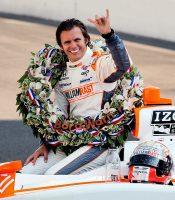
1978-2011
This truly remarkable race car driver left his mark on the motorsports community in more ways than he could possibly imagine. Dan took up karting when he was just four years old. During his young career, he formed a rivalry with Jenson Button who went on to be a Formula 1 World Champion. In 1999, Dan made a decision that would change his life forever. He left Europe and moved to the United States. If he had found the funding needed to stay in the UK, he would have probably went on to be a Formula 1 World Champion but as fate would have it, he became an open wheel superstar on the other side of the pond. He quickly found success, winning the 1999 US F2000 National Championship before moving to Indy Lights in 2001 and then Indycar one year later.
In 2004, he won his first Indycar race at Motegi and ended the year as the championship runner-up to Tony Kanaan with three victories to his credit. In 2005, he obliterated the competition with six wins, as he captured his first Indycar championship. One of those wins came in the 89th running of the Indy 500 where he led 30 laps after starting 16th. In 2006, he won another historic race…the Rolex 24 Hours of Daytona. In Indycar, he tied Sam Hornish Jr. for the title but lost due to the series’ tiebreaker policy. When he returned to Panther Racing in 2009 after driving for both Ganassi and Andretti, he failed to reach victory lane and the two cut ties at the end of the 2010 season.
Wheldon did not have a ride in 2011 but managed to get a seat with Bryan Herta Autosport for the Indianapolis 500. It looked like Wheldon was going to finish 2nd in the legendary race for the 3rd consecutive year until race leader JR Hildebrand hit the wall just a few hundred feet from the line and no one, including me, could believe what we were witnessing. As he tried desperately to limp the car home in a shower of sparks, Wheldon blew by and stole the victory in spectacular fashion. Dan raced one other time that year…in the season finale at Las Vegas where he was hoping to win the $5,000,000 that Bruton Smith promised he would give to the winner if it wasn’t a full time Indycar driver. Obviously, that challenge set forth by Smith attracted a lot of ringers to the race and consequently, a lot of inexperience as well. The night prior to the event, Dan got his wife’s initials tattooed on his wrist and he recently found out that he would return full-time to Indycar in 2012 with Andretti as well as make his V8 Supercar debut in the Gold Coast 600 next weekend. Everything was going right for Dan Wheldon before it all went wrong on that Sunday afternoon in Las Vegas.
There was an intense feeling of trepidation among the drivers as they prepared for what was sure to be a wild race with a record number of cars entered. Just ten laps into the event though, disaster struck when two cars went spinning and half the field was wiped out in mere seconds. Fans and teams looked on in horror as car after car was launched into the air flying over one another at speeds upwards of 200mph. The lucky ones weaved through the debris field in shock and multiple drivers were injured in the vicious crash but none more so than Dan Wheldon. As cars slowed in front of him, he made contact with the rear wheel of I believe Paul Tracy sending him airborne for a few hundred feet. The car tumbled through the air before making hard contact with the wall and the catch fence causing the car to burst into flames and the commentators to cringe. Dan was killed instantly when his helmet struck a post in the catch fence. Like Dale Earnhardt, he lives on through a racecar. It’s called the DW12; the next generation Indycar that Wheldon helped develop and it was named after him in his honor. It is a safer, more durable car that will hopefully prevent another tragedy like what we had to endure on October 16th, 2011. Death may have taken the man but in its wake, a legend remains.
Ayrton Senna
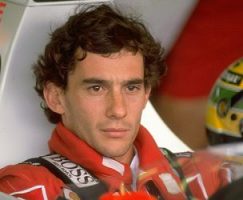
1960-1994
Ayrton Senna…..the greatest Formula 1 driver that ever lived. Michael Schumacher may have twice as many wins and seven titles to his credit but numbers aren’t everything. The remarkable way Senna could handle a race car like no other is what sets him apart from the rest Senna and longtime McLaren teammate Alain Prost were engaged in one of the most controversial and legendary rivalries in motorsports history. Their first encounter was long before they were paired up at McLaren though. Ayrton was a rookie in 1984 and stunned everyone when he started 13th in the Monaco Grand Prix and charged towards the front in treacherous wet conditions. Prost was leading the race and I can only imagine what he was thinking when he realized a rookie, in an inferior car nonetheless, was running him down. Prost used hand gestures to signal that he felt the race shouldn’t go on (even though the conditions had gotten slightly better) and the stewards listened to him…or should I say Jacky Ickx (clerk of the course) who designed Prost’s engine ended the race without consulting the stewards. Prost was declared the winner, Ickx was suspended for making the call on his own and the soon to be legendary Ayrton Senna had made his presence known.
The two became teammates at McLaren in 1988 and it didn’t take long for their relationship with one another to dissolve and turn quite hostile. Some say that Alain felt threatened by Ayrton’s arrival and that their distinctly different personalities combined with their unwavering need to out-do each other led to their now infamous rivalry. Senna once called Prost a coward in a press conference and Prost stated on another occasion that “he never wanted to beat me, he wanted to humiliate me” referring to Senna. Their tumultuous relationship came to a head in the 1989 Japanese Grand Prix. While battling for the lead in a race that would decide which one would emerge as the 1989 champion, the two collided. Prost calmly got out of his car knowing that the title was his but to his and everyone else’s surprise, Ayrton got his car fired back up and took off. After replacing his damaged front nose piece, he drove like a man possessed, winning the race and the championship. Following the event though, he was disqualified after Prost pleaded with the stewards for what most call a bogus penalty…he was disqualified for “cutting the track” when he got back going but if you look at the video, there was no other logical route to take back onto the course and he obviously gained no advantage by it. When the team protested, the stewards suspended Senna and claimed he was a “dangerous driver.” Due to the penalty, Alain Prost won the championship that would have otherwise belonged to Senna. The bridge between Prost and Senna was withering before this race and with everything that went down in Suzaka, you could say that the proverbial bridge went up in flames.
The following year, Senna would have his vengeance in the very same race. Like 1989, the politics of the sport were going against Senna and in favor of Prost. The two were once again battling for the title and started 1st and 2nd for the race. Ayrton went to the stewards because he thought hat as pole sitter, he shouldn’t be put on the dirtier side of the track. They initially agreed until FISA president and Prost’s fellow countryman, Jean Marie Balestre stepped in and rescinded the initial decision. Senna was not going to bow to the politics of the sport though. He vowed that he would do whatever he could to take the lead in the first corner, no matter the consequences. If they both were to wreck, Senna would clinch the title by the way. Surprise, surprise, the two crashed in the first corner and Ayrton Senna was crowned the 1990 Formula 1 champion.
Ayrton could put his car places that few would dare, and even fewer could pull off. Senna was “a powerful combination of spectacular raw talent and sometimes terrifying determination” as BBC puts it. He seemed to enjoy to push the boundaries between absolute control and utter disaster saying once “On a given day, a given circumstance, you think you have a limit. And you then go for this limit and you touch this limit, and you think, ‘Okay, this is the limit.’ As soon as you touch this limit, something happens and you suddenly can go a little bit further. With your mind power, your determination, your instinct, and the experience as well, you can fly very high.” Just one of Senna’s many famous quotes.
He took the car beyond its own limits and somehow made it work with both the finesse of Jimmy Clarke and the ruthlessness of the highly aggressive Michael Schumacher. One of his greatest performances came in a rain marred race at Brazil in 1991; his home track. He amazingly held on in the slick conditions with only sixth gear, pushing himself past the point of exhaustion, and he collapsed in agony after winning the race. He won over 25% of the races he entered in, captured pole position 65 times in 161 starts and finished on the podium in half the races he was in. The 3x Formula 1 World Champion won at F1’s most difficult track (Monaco) six times including five in a row between 1989 and 1993.
In the three races he competed in during the 1994 season, Senna captured pole position for every single event. The San Marino Grand Prix on May 1st, 1994 was the final time the world would get the chance to witness this man’s incredible ability before he would be taken from us forever. On Friday, there was a vicious airborne accident involving Rubens Barrichello who escaped the crash with only a broken nose. A day before the event, Austrian Roland Ratzenberger lost his life in a practice accident. When a tearful Senna arrived on the scene, Chief Medical Professor Sid Watkins suggested that Ayrton retire and go fishing which is a hobby the two men shared but Ayrton told him he could never quit racing. Everyone could tell that the usually cool and collected Senna was distressed and uneasy prior to the race commencing. At the start, a crash ensued at the finish line and debris flew into the grand stands injuring eight people. Perhaps all this was an ominous warning of what was to come.
On lap seven, race leader Ayrton Senna suffered a mechanical failure and his Williams hurled towards into a concrete barrier at 135mph. The right front tore from the car and a suspension arm pierced his helmet during the wreck causing fatal head injuries. When he was extracted from the mangled car, an Austrian flag was found that Senna had apparently planned to raise following the event in honor of the late Roland Ratzberger who had died just one day earlier. Erik Comas, who’s life was saved by Senna two years earlier after a scary crash, immediately withdrew from the race. This man who spoke so eloquently and drove so ferociously striking fear into the hearts of his competitors was gone just like that. Over 3,000,000 mourners showed up for the funeral which is considered one of the largest ever next to Princess Diana’s. Since that fateful day in May of 1994, not another Formula 1 racer has lost his life due to the advancement in safety following the loss of this legend. No one before or since Ayrton Senna in Formula 1 has showed the passion and raw talent that he possessed and I doubt we will ever get the chance to witness it again.
Dale Earnhardt
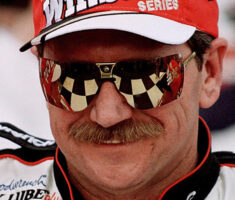
1951-2001
Dale Earnhardt; to understand what made this man so incredible you must first know where he came from. While Ayrton Senna was solidifying himself as the greatest Formula 1 driver that ever lived, Earnhardt was doing the same thing in NASCAR. He came from very humble beginnings that started in Kannapolis, North Carolina. His father Ralph was widely considered the best short track racer in North Carolina but he didn’t want his son to follow in his footsteps. Dale dropped out of high school and ignored his father’s wish as he set his sights on racing. The thing that made Dale such a formidable opponent was not only the obvious fact that he could wheel a race car better than most, but that he was willing to do whatever it took to win. If he failed, he knew that he was going to have to spend the rest of his life working at that mill in Kannapolis, North Carolina and no way was he going to settle for that. He carried that mentality through his entire career; even when he was a multimillionaire. Dale’s story is one of perseverance, tragedy, hardship and tough love. Dale lost his father when he was still relatively young, forcing him to grow up real fast. His first wife left him because he couldn’t pay the bills and Earnhardt was basically broke.
He kept fighting though and made his NASCAR debut in 1975 at Charlotte Motor Speedway, finishing one spot ahead of a man by the name of Richard Childress. Those two had no idea at the time that they were destined for greatness with each other. In 1978, Rod Osterlund offered the young Earnhardt a one race deal at Atlanta Motor Speedway. Earnhardt exceeded all expectations, finishing a very impressive 4th which prompted Osterlund to give him a full time ride in 1979. Dale won the championship in just his second full-time season in 1980. The likes of Neil Bonnett, Dan Gurney and Buddy Baker were unable to win a single race for Osterlund, but somehow this kid goes out and wins the title just like that. He partnered with Richard Childress Racing in the early 80’s and quickly took this team that ran mid-pack for years and made them championship caliber. Drivers that can take sub-par equipment to victory lane on a regular basis are a rare breed. As Dale kept winning and the money kept pouring in, the cars got faster and Earnhardt got harder to beat. Dale won six more title in 1986, 1987, 1990, 1991, 1993, and 1994.
He started off as the loud mouth kid with a cowboy hat, known as “Iron head” and quickly became the most feared competitor on the tracj, commonly referred to as “The Intimidator.” He claimed he could see the air and made moves that baffled all those fortunate enough to witness it. The final win of his career came in spectacular fashion at Talladega, when Earnhardt took a car that was beat all to hell, passed nearly the entire field in just a few laps and won the race. Another example of his extraordinary talent was when he got turned completely sideways and into the grass at 180mph during the 1987 All-Star Race but amazingly, he kept the car pointed in the right direction and in the lead. He went on to win the event in the move now famously known as “The Pass in the Grass.” His driving style was rough and merciless, never willing to give anyone an inch. He once said “The winner ain’t the one with the fastest car, it’s the one who refuses to lose”
Along with a NASCAR record of seven championships, he was a 4x IROC titlist and a runner-up in the 2001 24 Hours of Daytona. In 1994, tragedy struck close to Dale when his best friend Neil Bonnett was killed in a crash in turn 3 during practice for the 1994 Daytona 500; Dale would strangely meet a similar fate in the same spot seven years later. He won almost everywhere but ironically, the one race that eluded him was at the track that he won at more than any other; the Daytona 500. His 34 victories at Daytona is a record no one has even come close to but no matter how hard he tried, he couldn’t win the Daytona 500; NASCAR’s biggest race. He finished 2nd multiple times, ran out of fuel in the lead, blew a tire with ¼ of a lap to go, flipped over, and even hit a seagull. In 1998, a little girl in a wheel chair gave Earnhardt a penny for good luck and Dale decided to glue it to the dashboard of his racecar. Perhaps the lucky penny from that sweet little girl kept the bad luck that had plagued Earnhardt for so long here away. After 20 years of failed attempts, Dale Earnhardt finally won the Daytona 500 that year and in an unprecedented move by his competitors, every member from every crew lined up to congratulate “The Man in Black.”
Three years later, Dale owned his own team and was hoping to win another 500 after his 2nd place finish in the championship at the age of 49; not many people that age still had the ability to run competitively. It was a wild Daytona 500 and late in the race, there was a scary crash where Tony Stewart flipped over wading up nearly the entire field. The very first car to emerge from the carnage unscathed was the black No.3 of Dale Earnhardt. At the end of the event, the Dale Earnhardt owned cars of Michael Waltrip and Dale Jr. led the race with Dale Sr. following close behind. For the first time ever, Earnhardt drove defensively and showed no interest in going after the victory. In a very selfless act that proved costly in the end, he threw his chances of winning away and instead, intended to hold off the snarling pack of 15 drivers’ hell bent on taking the win for themselves. He succeeded; that is until the last turn of the last lap of the race. The field was spread out three wide behind him and as Dale came down to block Sterling Marlin just a few hundred feet from the line, he got hit. His car went onto the apron and Dale yanked the wheel to the right attempting to straighten it out but to no avail. He shot up the track and went head-on into the wall. During the impact, his seat belt snapped and he hit the steering wheel while wearing an open face helmet at 170mph killing this NASCAR legend instantly. The world was shocked and no one could bring themselves to believe it.
Fans loved him because he was a good ‘ol boy and drivers admired and envied his incredible abilities. Even when he was making millions, he decided to spend his days away from the track hunting and working on his farm. He was the real deal, nothing fake about him. One week after Daytona, Dale Earnhardt Inc. driver Steve Park won at Rockingham. Two weeks after that, rookie Kevin Harvick who took over Earnhardt’s seat won at Atlanta. Five months later when NASCAR revisited Daytona for the first time since that tragic day, Dale Jr. took the victory with none other than DEI teammate, Michael Waltrip 2nd. Dale Earnhardt affected NASCAR in so many different ways and the sport has never been the same since Black Sunday. Hans Devices became mandatory, the Car of Tomorrow was developed and safer barriers were mandated at every track that sanctioned a NASCAR race. Since his death, not a single national touring driver has lost his life and we can thank Dale Earnhardt for that. When people think of the word NASCAR, they instantly think of the name Earnhardt because he was the face of NASCAR; always was and always will be.
Epilogue
These are just nine of the many men that have paid the ultimate price, in the endless crusade to capture the checkered flag. Drivers such as Tiny Lund, Neil Bonnett, Gilles Villeneuve and Peter Brock are some that I was forced to leave out of this story due to time restrictions but they are certainly legends in their own right. Some were taken from us outside the race car too, such as Graham Hill, Tim Richmond, Davey Allison, Alan Kulwicki and Colin McRae. I hope you learned something from this article and that it helped you better understand these fantastic racers and who they really were. Please share this piece so that others may know about these brave men and what they did.
There are drivers that win a lot, others that make it into Hall of Fames all across the motorsports world, but there are a select few that reach a heroic level of immortality. These nine made it to that point; they will never be forgotten and will always be missed. They race on and I’m sure it’s quite a sight up there with Earnhardt and Senna dueling wheel-to-wheel, neither giving an inch as they battle for racing supremacy. Turner and Weatherly are most likely looking on and fighting over a bottle of Canadian Club Whiskey. I bet Jimmy Clarke and Graham Hill are reminiscing about their many battles as Bruce McLaren looks over some new car designs. Mark Donohue is probably close by, trying to tell Bruce what he’s doing wrong and bragging about how the Porsche 917/10 stopped the McLaren domination in Can-Am. The Rapid Roman is certainly searching around for a short track race to dominate while Dan Wheldon looks down on his family as he waits for the day when they will be reunited. I’d like to end this with a famous quote that I think best describes these nine racers…”Heroes are always remembered, but legends…legends never die.”
“The winner ain’t the one with the fastest car, it’s the one who refuses to lose” –Dale Earnhardt
“If you no longer go for a gap that exists, you are no longer a racing driver.” –Ayrton Senna
“We’re far from having too much horsepower…my definition of too much horsepower is when all four wheels are spinning in every gear.” –Mark Donohue
“I’m a racing driver, always was, always will be” –Bruce McLaren
“You got to be mentally tough, you got to physically tough, you got have good endurance…it’s all part of being an Indycar series driver. It’s that kind of element of fear that makes it so exciting to watch….lose the fear, win the race.” –Dan Wheldon

